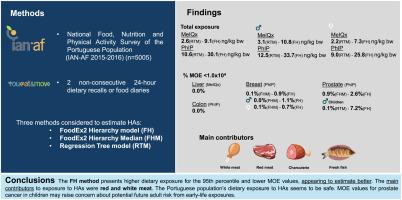葡萄牙人群饮食中对杂环胺的暴露:不同暴露评估方法的比较
IF 3.5
3区 医学
Q2 FOOD SCIENCE & TECHNOLOGY
引用次数: 0
摘要
为了估计葡萄牙人群中杂环胺(HAs)的饮食暴露,比较了三种将HAs发生数据归因于食用食物的方法。参与者是国家食品、营养和体育活动调查(n = 5005,3 -84y)的一部分。通过两次非连续的24小时饮食回顾或食物日记收集食物消耗。我们从文献中摘录了这一事件。对不同癌症类型的暴露边缘(MOE)进行了估计。考虑了三种方法:1。FoodEx2层次模型(FH) -随机HAs值归因于缺失数据,根据FoodEx2层次考虑发生数据集中最接近的项;2.FoodEx2层次中位数模型(FHM) -数据集中最接近项目的中位数HAs值归因于缺失数据;3.回归树模型(RTM) -基于fooddex2层次结构,使用RTM预测同质食物组的平均发生值。FH方法对第95百分位的膳食暴露量较高,MOE值较低,似乎估算得更好。红肉和白肉是HAs摄入量的主要来源。葡萄牙人从饮食中摄入的ha似乎是安全的。然而,儿童前列腺癌的MOE值可能会引起人们对成年后早期接触前列腺癌的潜在风险的关注。本文章由计算机程序翻译,如有差异,请以英文原文为准。

Dietary exposure to heterocyclic amines by the Portuguese population: comparison of different exposure assessment methods
To estimate dietary exposure to heterocyclic amines (HAs) in the Portuguese population, three methods of attributing HAs occurrence data to consumed food items were compared. Participants are part of the National Food, Nutrition and Physical Activity Survey (n = 5005, 3-84y). Food consumption was collected through two non-consecutive 24 h dietary recalls or food diaries. HAs occurrence was extracted from the literature. Margins of exposure (MOE) were estimated for different cancer types. Three methods were considered: 1.FoodEx2 Hierarchy model (FH) - random HAs values were attributed to missing data, considering the closest item in the occurrence dataset according to the FoodEx2 hierarchy; 2.FoodEx2 Hierarchy Median model (FHM) - median HAs values of the closest items in the dataset were attributed to missing data; 3.Regression Tree model (RTM) - an RTM was used to predict mean occurrence values of homogeneous food groups based on the FoodEx2 hierarchy. The FH method presents higher dietary exposure for the 95th percentile and lower MOE values, appearing to estimate better. Red and white meat were the main contributors to HAs intake. The Portuguese population's dietary exposure to HAs seems to be safe. However, MOE values for prostate cancer in children may raise concern about potential future adult risk from early-life exposures.
求助全文
通过发布文献求助,成功后即可免费获取论文全文。
去求助
来源期刊

Food and Chemical Toxicology
工程技术-毒理学
CiteScore
10.90
自引率
4.70%
发文量
651
审稿时长
31 days
期刊介绍:
Food and Chemical Toxicology (FCT), an internationally renowned journal, that publishes original research articles and reviews on toxic effects, in animals and humans, of natural or synthetic chemicals occurring in the human environment with particular emphasis on food, drugs, and chemicals, including agricultural and industrial safety, and consumer product safety. Areas such as safety evaluation of novel foods and ingredients, biotechnologically-derived products, and nanomaterials are included in the scope of the journal. FCT also encourages submission of papers on inter-relationships between nutrition and toxicology and on in vitro techniques, particularly those fostering the 3 Rs.
The principal aim of the journal is to publish high impact, scholarly work and to serve as a multidisciplinary forum for research in toxicology. Papers submitted will be judged on the basis of scientific originality and contribution to the field, quality and subject matter. Studies should address at least one of the following:
-Adverse physiological/biochemical, or pathological changes induced by specific defined substances
-New techniques for assessing potential toxicity, including molecular biology
-Mechanisms underlying toxic phenomena
-Toxicological examinations of specific chemicals or consumer products, both those showing adverse effects and those demonstrating safety, that meet current standards of scientific acceptability.
Authors must clearly and briefly identify what novel toxic effect (s) or toxic mechanism (s) of the chemical are being reported and what their significance is in the abstract. Furthermore, sufficient doses should be included in order to provide information on NOAEL/LOAEL values.
 求助内容:
求助内容: 应助结果提醒方式:
应助结果提醒方式:


